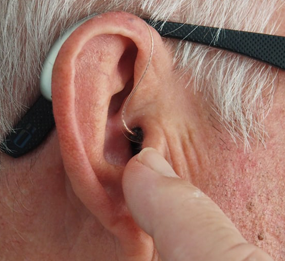
What is the best hearing aid on the market today?
Did you know that 48 million individuals in the US struggle with some degree of hearing loss? Yet only 1 in 5 individuals who could benefit from a hearing aid actually uses one.
If you’re struggling with some level of hearing loss, you might be wondering what the types of hearing aids are so you can hear clearly again. Maybe you’ve recently searched “What is the best hearing aid on the market today?”
Although a hearing solution can’t restore your hearing, it can help improve your ability to hear and, in turn, boost your quality of life. If you’re interested in learning about the latest cutting-edge hearing technology, read on. We’ll discuss the most common types of hearing aids and the pros and cons of each.
What is a hearing aid and its types?
A hearing aid is a device worn behind, on, or in the ear that assists people with hearing loss and helps them hear better. Hearing aids typically consist of three parts:
- A microphone to pick up sound
- An amplifier to increase the sound
- A receiver to deliver sound in the ear
A modern, digital hearing aid can help individuals with uneven hearing loss by boosting certain frequencies over others. For example, it can boost a person’s voice over background noise such as traffic or wind. The programing of the frequencies can be customizable. There are also analog hearing aids that boost all frequencies, and this type of hearing aid helps individuals with age-related hearing issues.
Types of hearing aid technology
There are two basic types of hearing aids: in-the-ear (ITE) hearing aids and behind-the-ear (BTE) hearing aids.
Behind-the-ear (BTE)
What type of hearing aid is a BTE? Put simply, a behind-the-ear (BTE) hearing aid sits behind or on top of the outer ear. It uses tubing that routes sound down into the ear canal. This tube is typically customer-fitted and doesn’t block the entire ear canal opening.
A BTE hearing aid can be very customizable. These hearing aids can come in different tones to match hair or skin. They can even come in bold colors and designs for a personalized flair. A BTE hearing aid usually comes with standard button batteries that should be replaced between 3-20 days. Rechargeable batteries are becoming more common for these types of hearing aids.
A BTE hearing aid is the most popular design, because the tubing and tips can be customized and changed out, making them the most comfortable for different ear sizes and shapes. The tubing and tips can also be removed for cleaning or replacement. The day-to-day maintenance on these types of hearing solutions can be managed easily without having to go into a clinic, however you still must go in to get them professionally fitted. BTE hearing aids are fairly budget-friendly when it comes to repairs.
Receiver-in-the-canal (RIC) also known as receiver in the ear” (RITE)
This style can go by two names: receiver-in-the-ear (RITE) or receiver-in-canal (RIC). The name depends on the manufacturer. These types of hearing aids are an open-fit style and have speakers built into an insertable ear dome. The speakers rest in the ear canal, but the microphone and processor sit in a tiny case behind the ear. The two are connected by a thin wire. This style of hearing aid is made by all major hearing aid manufacturers.
The replacements of the speaker can almost always be replaced at a hearing aid center.
Pros:
- Typically comes with a rechargeable battery
- Wireless connectivity
- Sometimes has advanced technology, such as artificial intelligence
Cons:
- The speaker on the inside of the ear may develop moisture and ear wax damage
- The microphone and sound processor sit behind the ear and is more visible than other models.
“Mini” BTE (or “on-the-ear”) aids
The Mini BTE, also known as “on-the-ear,” is a new type of hearing aid. Mini BTE is the smallest behind-the-ear hearing aid on the market today. It fits behind/on the ear but is small and sleek. A very thin tube is used to connect the aid in the ear canal—sometimes it can be nearly invisible—making it the most sleek and hidden version of the BTE hearing aids. Many Mini BTE are also RIC, meaning that the receiver is in the ear canal. These have comfortable earpieces that are mostly open fit.
Mini BTEs can reduce the plugged-up feeling many individuals can get in the inner ear canal when wearing other designs.
85% of hearing aids today are Mini BTE RIC, because of their small size and power. They also allow for natural low frequencies to travel well.
Pros:
- Comfortability
- Reduced feedback
- Comes with many features while addressing cosmetic concerns
Cons:
- The slightly smaller size can sometimes be a problem for those with dexterity loss
BTE with earmold
BTE styles with earmolds can assist nearly all types of hearing loss, from proud to mild. They have a longer shape that follows the contour of the outer ear. This style of hearing aid comes with more features, controls, and a higher battery power than any other type of hearing aid. The BTE with an earmold is typically used for children due to its reprogramming ease and earmold replacement as a child grows and their needs change.
Pros:
- Is useable for all degrees of hearing loss
- Can usually connect to wireless devices and advanced technology
- Can be custom fitted and earmold can be separately replaced
- Less prone to moisture and ear wax damage
Cons:
- The earmold is large so it can make the ear feel plugged
- Can cause space limitations for individuals with eyeglasses
- Very visible and not cosmetically hidden
In-the-ear (ITE)
In-the-ear (ITE) hearing aids are generally custom-fitted and worn in the ear canal. An impression is usually taken and the ITE hearing aid is molded to the ear. These impressions are usually taken by a health care provider at the time of a hearing aid consultation. Many ITE hearing aid styles are available in different skin tones so they blend with the outer ear. Some of these types of hearing aids are closer to the outer ear while others fit deeply within the ear.
Invisible in the canal (IIC) and Completely in the canal (CIC)
Invisible in the canal (IIC) is the smallest hearing aid available. This type of hearing aid is virtually invisible and can hardly be seen when a person is looking at the ear. The individual wearing the IIC hearing aid places them deeply into the ear canal. They can only be removed by tugging on a small string.
Completely in the canal (CIC) is almost identical to the IIC hearing aids, they just sit a little further outside the ear.
Both of these styles are for individuals with mild to moderate hearing problems. Although their small size makes for a great factor when it comes to visibility, they don’t typically come with manual controls, such as volume wheels or program buttons.
Pros:
- Very subtle
- Excellent sound quality because they fit snugly within the ear
Cons:
- Can’t always connect to wireless devices, like a smartphone
- Small size can be an issue for dexterity
- Can be open to ear wax and moisture damage because of how far they sit in the ear
In-the-canal (ITC)
An in-the-canal (ITC) hearing aid is easy to use and comfortable. They typically sit in the lower portion of the outer ear bowl. They tend to have a slightly longer battery life and can fit a wider range of hearing losses due to their slightly bigger style. Because they’re bigger than an IIC or a CIC, they can have additional features such as directional microphones so individuals can better hear in a noisy environment. They can also feature manual controls, like a volume wheel.
Pros:
- Although slightly bigger, they’re still subtle and discreet
- Longer battery life and additional features compared to IIC and CIC
Cons:
- Still prone to ear wax and moisture damage
- Can sometimes feel like a block in the ear and makes a person’s ear feel plugged
- Can sometimes have problems connecting to wireless devices due to small size.
Low-profile
Low-profile hearing aids are very similar to the ITC hearing aid. Low-profiles range from “half-shell” designs that fill half of the outer ear bowl to “full-shell” designs that fill nearly the entire outer ear bowl. Similar to the ITC, a low-profile design is large enough to have directional microphones and manual controls. Along with a volume wheel, it can also have a push-button for changing programs. The slightly larger size of a low-profile device can help people with dexterity problems since it is easier to handle than an IIC, CIC, or ITC.
Pros:
- Slightly larger size makes them easier to insert and remove from ear
- Allows for more features and user controls
- Can connect to wireless devices
Cons:
- Less subtle and discreet compared to other styles
- Since it covers the entire bowl of the inner ear, it can make a person’s ear feel plugged
Alpaca Audiology—transforming the practice of audiology
Not only can these hearing solutions help improve your hearing by amplifying sounds that can be difficult to hear, but they can help you improve your overall quality of life. Depending on your level of hearing loss and the features that are important to you, an audiologist can recommend specific types of hearing aids. However, hearing aids can come with a large price tag, so it’s in your best interest to do your research and compare prices along with the pros and cons of each type of aid.
Here at Alpaca Audiology, we’re proud to offer the most advanced hearing solution technology available, and we’re driven by an unwavering desire to provide excellent experiences and outcomes for our patients.
Find a clinic to get started on your journey to better hearing.

